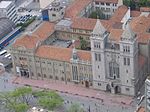Catavento Museum

The Catavento Museum is an interactive museum, inaugurated in 2009. It is dedicated to science and its dissemination, and is located in the Palácio das Indústrias ("Palace of the Industries"), in São Paulo, Brazil. The 12,000 square meter space is divided into 4 sections: "Universo" ("Universe"),"Vida" ("Life"), "Engenho" ("Ingenuity") and "Sociedade" ("Society") and has more than 250 installations. Aimed at young audiences, it was founded by the state secretariats of culture and education, with an investment of 20 million reais after 14 months of construction.Although the museum began operating in 2009, the São Paulo City Hall had been discussing its creation since 2005, when it sent bill 469/2005 to the Municipal Chamber to authorize the Executive to establish the Catavento Foundation. The bill was only approved and transformed into law 14.130 in 2006, after a year of processing and alteration of the original text by politician Chico Macena, who defended the creation of the Catavento Foundation to create and manage the Children's Museum and not just a center for the development of children and adolescents.
Excerpt from the Wikipedia article Catavento Museum (License: CC BY-SA 3.0, Authors, Images).Catavento Museum
Avenida Mercúrio, São Paulo Glicério
Geographical coordinates (GPS) Address Nearby Places Show on map
Geographical coordinates (GPS)
| Latitude | Longitude |
|---|---|
| N -23.544166666667 ° | E -46.628055555556 ° |
Address
Palácio das Indústrias (Palácio da Agricultura e da Indústria)
Avenida Mercúrio
03007-000 São Paulo, Glicério
São Paulo, Brazil
Open on Google Maps











